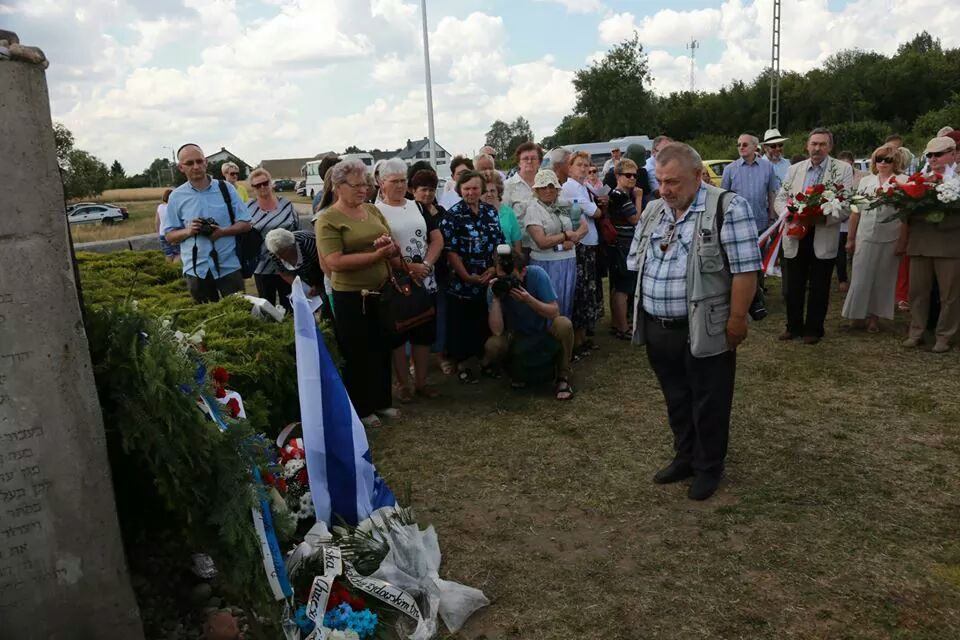Alternate name: Jebwabne. 53°17' 22°18'
REFERENCE: "Burning Alive" by Andrzej Kaczynski, [Polish newspaper] Rzeczpospolita , May 5, 2000. Translated by: Joanna Zimmerman [2000].
When the first Jews came to Jedwabne is unknown, but Julius Baker and Moshe Tzinowitz on "Jedwabne Book of Remembrance" states that Jews moved to Tykocin in 1736 from Jedwabne. Other sources cite 1664 as the beginning of settlement when Jewish families traveled to Jedwabne and probably settled here because of the weekly fair. The Encyclopedia of Jewish Life Before and During the Holocaust shows significant development of the Jewish community at the end of the 18th century. In 1808, 325 Jews (68%) lived here. In addition to trade, they were tailors and produced honey and alcoholic beverages. Jewish population went from 324 persons in 1827 to 1,941 in 1897. At the end of the 19th century, 77% of Jedwabne residents were Jewish. As a result of emigration to America and expulsion of Jews from Jedwabne by the Russians during the WW I, the number of Jewish residents fell dramatically. The 1921 census recorded only 757 Jews. [May 2009]
CEMETERY: Jewish cemetery is located right beside the place where, on July 10, 1941 many were murdered. Before the war, the cemetery had a low fence, a metal gate with the Ten Commandments. Now, walls of massive blocks of rock surround the road from the cemetery. The remaining boundaries are destroyed. Small granite stones are probably relic of the pre-war wall. The corner of the cemetery had a stylized matzevot monument with words in Polish and Hebrew: "Jewish cemetery in Jedwabne, founded in the nineteenth century. Eternal resting place of Jews from Jedwabne and surrounding areas. Jewish Graves of those murdered 10 July 1941. Part of their memory." The cemetery now has dense forest growth. Visible among the trees are some thirty, granite gravestones. Most are simple gravestones, devoid of any decoration with equally simple epitaphs. Among them are the gravestone of Jehuda ben ____ with inscriptions and images of lions at the top. A few years ago Tomasz Wisniewski and Ada Holtzman read and translated the Hebrew epitaphs. One of them: "modest and serious daughter Mrs. Zelig Israel Ha-Levi. Heszvan 660 She died 1 year (5 October jedwabne1899). The cemetery register of historic buildings number is 374/88. One of the inhabitants of Jedwabne gave this contemporary account: "That's not the Germans. Stones of the tombs were for the construction of our walls and chlewów. The fencing was like in our cemetery; and that also has been ruined." video. photos. [May 2009]
MASS GRAVE: A dozen meters from the gate is a small depression, one of the unmarked graves where they buried victims of the 1941 mass murder. Leon Dziedzic, who as a boy observed the burned bodies of Jews in the barn, in his article published in "Rzeczpospolita", "Do not kill", on 10.07.2000) he mentions collective graves in the cemetery: "the dead bodies of Jews, who died the same day, July 10, but earlier, they were not burned in the barn, but murdered in the city, to destroy the Jewish cemetery monument to Lenin, or caught trying to escape and hide in the field or in the woods, it was not on top, but freshly dug ground on the other side of the road in the cemetery. The Jewish cemetery was fenced with a low fence with a gate adorned with the Ten Commandments. People say that the Jews [przymuszono?] to each other for the excavated tomb." [May 2009]
Dedication of mass grave memorial [2014]
[UPDATE] Review of book by Anna Bikont: The Crime and the Silence: Confronting the Massacre of Jews in Wartime Jedwabne [September 2015]

